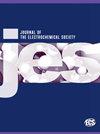基于 VMD-DBO-SVR 模型的电动汽车锂离子电池健康状况评估
IF 3.3
4区 工程技术
Q2 ELECTROCHEMISTRY
引用次数: 0
摘要
锂离子电池的健康状态(SOH)是衡量电池性能和剩余寿命的重要指标。我们提出了一种创新的预测模型,该模型集成了变模分解(VMD)、蜣螂优化器(DBO)和支持向量回归(SVR)算法。我们从放电特性曲线和增容曲线中提取了相关特征。我们使用皮尔逊和斯皮尔曼相关系数方法对提取的健康因素(HFs)进行相关分析,选择对 SOH 有显著影响的健康因素作为输入特征。构建的 DBO-SVR 模型在 HFs 和 SOH 之间建立了非线性相关性,并使用 DBO 算法对 SVR 模型的超参数进行全局搜索和优化,以提高其预测准确性。为减少电池信号中的噪声对模型性能的影响,引入了 VMD 技术,将电池信号分解为多个本征模式成分,提取有用特征并去除噪声,从而进一步提高预测精度。利用 NASA 电池数据集对所提出的方法进行了验证,并与其他算法模型进行了比较。结果表明,该预测模型明显优于其他模型,最大 RMSE 值为 0.84%,最大 MAE 值为 0.71%,预测误差值稳定在 1%以内。本文章由计算机程序翻译,如有差异,请以英文原文为准。
State of Health Estimation of Lithium-Ion Battery for Electric Vehicle Based on VMD-DBO-SVR Model
State-of-health (SOH) of lithium-ion batteries is an important indicator for measuring performance and remaining life. We propose an innovative prediction model that integrates variational mode decomposition (VMD), Dung Beetle optimizer (DBO), and support vector regression (SVR) algorithms. We extracted relevant features from the discharge characteristic curve and incremental capacity curve. We used Pearson and Spearman correlation coefficient methods for correlation analysis on the extracted health factors (HFs), selecting those that significantly impact SOH as input features. A DBO-SVR model was constructed to establish a nonlinear correlation between HFs and SOH, and the DBO algorithm was used to globally search and optimize the hyperparameters of the SVR model to improve its prediction accuracy. To reduce the impact of noise in battery signals on model performance, VMD technology was introduced to decompose battery signals into multiple intrinsic mode components, to extract useful features and remove noise to further improve prediction accuracy. The proposed method was validated using the NASA battery dataset and compared with other algorithm models. Results showed that the prediction model was significantly better than other models, with a maximum RMSE value of 0.84%, a maximum MAE value of 0.71%, and a stable prediction error value within 1%.
求助全文
通过发布文献求助,成功后即可免费获取论文全文。
去求助
来源期刊
CiteScore
7.20
自引率
12.80%
发文量
1369
审稿时长
1.5 months
期刊介绍:
The Journal of The Electrochemical Society (JES) is the leader in the field of solid-state and electrochemical science and technology. This peer-reviewed journal publishes an average of 450 pages of 70 articles each month. Articles are posted online, with a monthly paper edition following electronic publication. The ECS membership benefits package includes access to the electronic edition of this journal.

 求助内容:
求助内容: 应助结果提醒方式:
应助结果提醒方式:


